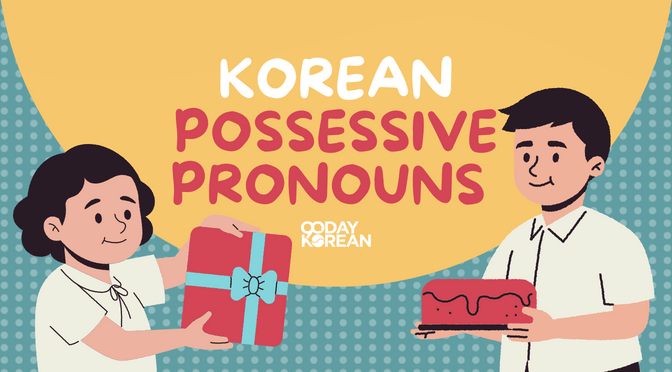In this article, we’ll dig deeper into Korean pronouns and learn about Korean possessive pronouns! Korean pronouns are yet another crucial Korean grammar to learn.
As you know from any language’s grammar lessons, a possessive pronoun indicates that something (item, building, and so on) belongs to someone.
We’ll teach you everything you need to know in this post. Let’s get to it!
Contents
List of Korean possessive pronouns
Below you can find Korean possessive pronouns, including a short explanation of their use.
“Of” in Korean
의 (ui) is the main formal possessive pronoun to be used. It is attached to the subject of the sentence, so the person or thing possesses the pronoun.
For example, you might want to say that Rena has a book. Rena is written as 레나 (rena) in Korean. Meanwhile, the word for “book” in Korean is 책 (chaek). If you want to say that a book is Rena’s, you will want to attach 의 (ui) to 레나 (Rena). Like this:
레나 (rena) + 의 (ui) = 레나의 (renaui)
The word for book, 책, will, of course, follow the subject. Like this:
레나의 책 (renaui chaek)
This sentence would then translate as “Rena’s book.”
In other words, while it officially means “of,” 의 (ui) works quite similarly to possessive pronouns in other languages. The possessive pronoun 의 (ui) is not only attached to third-person pronouns but is also used for first-person, second-person, and so on.
However, in these cases, as we will show below, it may appear a little differently to make sentences sound more natural and less clunkily formal.
First-person possessive pronouns
Now that you’re familiar with the general way to build a possessive pronoun, we can move forward to teaching you how to specifically use it in the first person and so on. Let’s first talk about the first-person pronouns.
As you may remember, “me” in Korean is 저 (jeo) on a more polite and honorific level and 나 (na) when speaking casually. When you want to turn them into the possessive “my,” all you need to add is 의 (ui). In other words:
저 (jeo) + 의 (ui) = 저의 (jeoui)
나 (na) + 의 (ui) = 나의 (naui)
However, you will rarely see these possessive pronouns in motion like this. Instead, these possessive determiners are typically shortened just a little bit. This will help ease the flow of the word. Therefore, rather than 저의 (jeoui) and 나의 (naui), Koreans will use 제 (je) and 내 (nae). Here is an example that may help you understand.
저의 책 (jeoui chaek) → 제 책 (je chaek)
나의 책 (naui chaek) → 내 책 (nae chaek)
As you may remember from above, the word 책 (chaek) means “book.” So, all of these short phrases mean “my book.” Either way you spell it out is correct, but as you may also notice, 제 (je) and 내 (nae) will roll off your tongues, keyboards, and pens a lot more naturally than 저의 (jeoui) and 나의 (naui).
For the plural form, you don’t need to change anything. Just replace 저 (jeo) with 우리 (uri).
Second and third-person possessive pronouns
In comparison to some other languages, such as the English language, determiners of possessive second-person pronouns are rare. Instead, as seen in the examples above, it is more common to use third-person possessive pronouns even when technically speaking in the second person.
Depending on the situation, you may only need to use someone’s name, although, in this case, it’s largely used in casual conversations. In most scenarios, you will add the person’s title to their name and refer to them by their surname rather than their first name. For example, when using formal language, the example from the first section could turn out to be like this:
레나 씨의 책 (rena ssiui chaek)
Oftentimes, Koreans like to drop 의 (ui) entirely when spoken outside of the first person, especially in non-honorific situations. So don’t get startled if you accidentally say or write 레나 씨 책 (renassi chaek) instead of 레나 씨의 책 (renassiui chaek). Grammatically it may be wrong, but in everyday speech, it is perfectly fine to use, and would also be how Koreans do it.
Other Korean words you may use instead of name and title are the following Korean pronouns:
“You”
당신 (dangsin)
그대 (geudae)
너 (neo)
“He,” “she,” and “they”
그 (geu)
그녀 (geunyeo)
그들 (geudeul)
“Mine,” “Yours,” “His,” “Hers” in Korean
When you want to explain that something is someone’s, you will simply add 것 (geot) and the be verb 이다 (ida) to the possessive determiner. So, going back to the book example, you may also say it like this:
저 책은 레나 씨 것이에요 (jeo chaegeun raenassi geosieyo)
That book is Rena’s.
Notice, however, that here we are talking about “that book” rather than simply “Rena’s book.”
On a more informal level, you may use 꺼 (kkeo) instead of 것 (geot). It is also more commonly used by Koreans, which is why you may see it in use even in more polite language.
“Our” in Korean
The formal way to say “our” in Korean is 저희의 (jeohuiui), while 우리의 (uriui) is used when you are speaking informally.
The possessive particle 의 (ui) is used with 저희 (jeohui) and 우리 (uri) to express “our” in Korean. However, 의 (ui) is often omitted from both words, so you can also use only 저희 (jeohui) or 우리 (uri) to say “our.”
Wrap Up
And there you have it! You can now introduce people to your books, cars, and so on! If you’d like to learn more about Korean personal pronouns instead, these are covered in this separate article on Korean pronouns.





